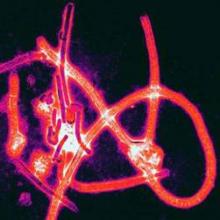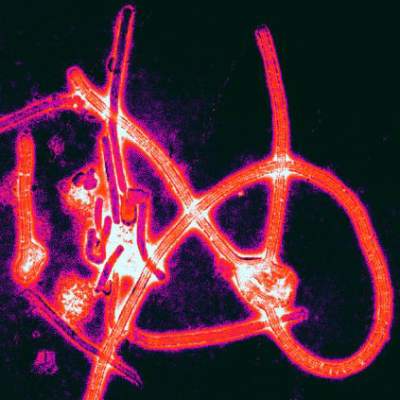User login
Isolating patients, more than a rollout of vaccines or any change in treatment strategy, is the cornerstone of the international effort to contain the Ebola outbreak in West Africa, say officials leading the response.
Steve Monroe, Ph.D., deputy director of the National Center for Emerging and Infectious diseases at the U.S. Centers for Disease Control and Prevention, summarized the state of the outbreak and the international response in a news conference Sept. 30, hours before the agency revealed the first imported case of Ebola documented in the United States in a traveler returning from Liberia.
In the two worst-affected countries, Sierra Leone and Liberia, cases are doubling approximately every 3 weeks. “One of the things CDC modeling data show is that we must get cases into isolation and treatment,” Dr. Monroe said. “We know how to control these outbreaks: Get patients into isolation so they don’t infect other people, and then follow their contacts.”
To stem the outbreak “we need to get, at a minimum, 70% of cases into effective isolation,” he said, and though increasing the number and location of Ebola treatment units was key to this effort, “all strategies should be considered,” including community centers, he said. “We can’t let the perfect be the enemy of the good. Every delay results in an increasing number of people impacted by this disease.”
In Senegal and Nigeria, Dr. Monroe noted, no new cases have been reported in the past 21 days, suggesting that containment efforts have proven effective in these countries and demonstrating that outbreaks “can be brought under control” through rigorous isolation, notification of contacts, and breaking the chain of transmission. Both countries would “recognize if there is another importation and respond quickly,” he said.
Sophie Delaunay, executive director of Doctors Without Borders/Médecins Sans Frontières (MSF), also speaking at the news conference, characterized her organization as feeling “desperate and powerless” in the most affected countries but ready to respond to any sign of outbreak in neighboring countries thanks to extensive preparation work.
Ms. Delaunay added that MSF is also prioritizing isolation and safe burial of patients who have died from Ebola. “In an ideal situation, a safe and effective vaccine would be the best potential game changer … but this is not likely to be available until several months from now. In the meantime, we absolutely need to increase the [capacity for] isolation.”
Dr. Monroe noted that data indicate there has been very little evidence of community transmission related to public transportation or other settings of casual contact, with most cases attributable to direct patient care or funeral practices. “Those are the main drivers of transmission,” he said during the conference, sponsored by the Kaiser Family Foundation.
The U.S. government has, to date, pledged $175 million for the Ebola response, with a little more than half the total already committed, with some $58 million marked for vaccine and antiviral drug development. Two vaccines are sponsored for clinical trials and likely to go into phase 2 testing during the course of the current outbreak, Dr. Monroe said. The U.S. Department of Defense has an additional $500 million to $1 billion in supplemental war funding that can be used to fight Ebola in West Africa, though it is unknown how much of this will be committed to Ebola.
Ms. Delaunay said that MSF has received pledges of $120 million, much of it from private donors, of which about half has been received.
The organization is preparing medical staff weekly in Belgium before they deploy to West Africa, she said, adding that, while getting more treatment units on the ground is a key priority, the quality of the response is dependent on how rigorous and disciplined the treatment of patients is. “You need to have strong discipline and chain of command,” she said.
Isolating patients, more than a rollout of vaccines or any change in treatment strategy, is the cornerstone of the international effort to contain the Ebola outbreak in West Africa, say officials leading the response.
Steve Monroe, Ph.D., deputy director of the National Center for Emerging and Infectious diseases at the U.S. Centers for Disease Control and Prevention, summarized the state of the outbreak and the international response in a news conference Sept. 30, hours before the agency revealed the first imported case of Ebola documented in the United States in a traveler returning from Liberia.
In the two worst-affected countries, Sierra Leone and Liberia, cases are doubling approximately every 3 weeks. “One of the things CDC modeling data show is that we must get cases into isolation and treatment,” Dr. Monroe said. “We know how to control these outbreaks: Get patients into isolation so they don’t infect other people, and then follow their contacts.”
To stem the outbreak “we need to get, at a minimum, 70% of cases into effective isolation,” he said, and though increasing the number and location of Ebola treatment units was key to this effort, “all strategies should be considered,” including community centers, he said. “We can’t let the perfect be the enemy of the good. Every delay results in an increasing number of people impacted by this disease.”
In Senegal and Nigeria, Dr. Monroe noted, no new cases have been reported in the past 21 days, suggesting that containment efforts have proven effective in these countries and demonstrating that outbreaks “can be brought under control” through rigorous isolation, notification of contacts, and breaking the chain of transmission. Both countries would “recognize if there is another importation and respond quickly,” he said.
Sophie Delaunay, executive director of Doctors Without Borders/Médecins Sans Frontières (MSF), also speaking at the news conference, characterized her organization as feeling “desperate and powerless” in the most affected countries but ready to respond to any sign of outbreak in neighboring countries thanks to extensive preparation work.
Ms. Delaunay added that MSF is also prioritizing isolation and safe burial of patients who have died from Ebola. “In an ideal situation, a safe and effective vaccine would be the best potential game changer … but this is not likely to be available until several months from now. In the meantime, we absolutely need to increase the [capacity for] isolation.”
Dr. Monroe noted that data indicate there has been very little evidence of community transmission related to public transportation or other settings of casual contact, with most cases attributable to direct patient care or funeral practices. “Those are the main drivers of transmission,” he said during the conference, sponsored by the Kaiser Family Foundation.
The U.S. government has, to date, pledged $175 million for the Ebola response, with a little more than half the total already committed, with some $58 million marked for vaccine and antiviral drug development. Two vaccines are sponsored for clinical trials and likely to go into phase 2 testing during the course of the current outbreak, Dr. Monroe said. The U.S. Department of Defense has an additional $500 million to $1 billion in supplemental war funding that can be used to fight Ebola in West Africa, though it is unknown how much of this will be committed to Ebola.
Ms. Delaunay said that MSF has received pledges of $120 million, much of it from private donors, of which about half has been received.
The organization is preparing medical staff weekly in Belgium before they deploy to West Africa, she said, adding that, while getting more treatment units on the ground is a key priority, the quality of the response is dependent on how rigorous and disciplined the treatment of patients is. “You need to have strong discipline and chain of command,” she said.
Isolating patients, more than a rollout of vaccines or any change in treatment strategy, is the cornerstone of the international effort to contain the Ebola outbreak in West Africa, say officials leading the response.
Steve Monroe, Ph.D., deputy director of the National Center for Emerging and Infectious diseases at the U.S. Centers for Disease Control and Prevention, summarized the state of the outbreak and the international response in a news conference Sept. 30, hours before the agency revealed the first imported case of Ebola documented in the United States in a traveler returning from Liberia.
In the two worst-affected countries, Sierra Leone and Liberia, cases are doubling approximately every 3 weeks. “One of the things CDC modeling data show is that we must get cases into isolation and treatment,” Dr. Monroe said. “We know how to control these outbreaks: Get patients into isolation so they don’t infect other people, and then follow their contacts.”
To stem the outbreak “we need to get, at a minimum, 70% of cases into effective isolation,” he said, and though increasing the number and location of Ebola treatment units was key to this effort, “all strategies should be considered,” including community centers, he said. “We can’t let the perfect be the enemy of the good. Every delay results in an increasing number of people impacted by this disease.”
In Senegal and Nigeria, Dr. Monroe noted, no new cases have been reported in the past 21 days, suggesting that containment efforts have proven effective in these countries and demonstrating that outbreaks “can be brought under control” through rigorous isolation, notification of contacts, and breaking the chain of transmission. Both countries would “recognize if there is another importation and respond quickly,” he said.
Sophie Delaunay, executive director of Doctors Without Borders/Médecins Sans Frontières (MSF), also speaking at the news conference, characterized her organization as feeling “desperate and powerless” in the most affected countries but ready to respond to any sign of outbreak in neighboring countries thanks to extensive preparation work.
Ms. Delaunay added that MSF is also prioritizing isolation and safe burial of patients who have died from Ebola. “In an ideal situation, a safe and effective vaccine would be the best potential game changer … but this is not likely to be available until several months from now. In the meantime, we absolutely need to increase the [capacity for] isolation.”
Dr. Monroe noted that data indicate there has been very little evidence of community transmission related to public transportation or other settings of casual contact, with most cases attributable to direct patient care or funeral practices. “Those are the main drivers of transmission,” he said during the conference, sponsored by the Kaiser Family Foundation.
The U.S. government has, to date, pledged $175 million for the Ebola response, with a little more than half the total already committed, with some $58 million marked for vaccine and antiviral drug development. Two vaccines are sponsored for clinical trials and likely to go into phase 2 testing during the course of the current outbreak, Dr. Monroe said. The U.S. Department of Defense has an additional $500 million to $1 billion in supplemental war funding that can be used to fight Ebola in West Africa, though it is unknown how much of this will be committed to Ebola.
Ms. Delaunay said that MSF has received pledges of $120 million, much of it from private donors, of which about half has been received.
The organization is preparing medical staff weekly in Belgium before they deploy to West Africa, she said, adding that, while getting more treatment units on the ground is a key priority, the quality of the response is dependent on how rigorous and disciplined the treatment of patients is. “You need to have strong discipline and chain of command,” she said.

